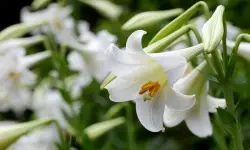Calla lilies (Zantedeschia spp.) are among the most elegant and striking flowers you can grow in your garden or keep as houseplants. Known for their trumpet-shaped blooms and lush foliage, they are a favorite for weddings, bouquets, and ornamental displays. But one of the most common questions about these plants is: Are calla lilies perennials or annuals? The answer isn’t as straightforward as it may seem—it largely depends on your climate and how you care for them.
In this article, we’ll explore the true nature of calla lilies, whether they’re annuals or perennials, and how to care for them based on your region. You’ll also learn essential tips for growing, storing, and maintaining calla lilies to enjoy their beauty year after year.
What Are Calla Lilies?
Botanical Background
Calla lilies belong to the genus Zantedeschia, not to be confused with true lilies in the Lilium genus. Despite the name, calla lilies are not true lilies at all. Native to southern Africa, particularly regions like South Africa, Swaziland, and Lesotho, calla lilies thrive in warm climates and can grow both in the ground and in containers.
These plants are known for their distinctive funnel-shaped flowers, which are technically spathes—a type of modified leaf that wraps around a central spike known as a spadix. The foliage is equally attractive, often dark green with white speckles.
Popular Varieties
There are several popular types of calla lilies, including:
Zantedeschia aethiopica – The classic white calla lily
Zantedeschia rehmannii – Pink calla lily
Zantedeschia elliottiana – Yellow calla lily
Each variety has slightly different needs, but they all share similar growing requirements and life cycles.
Perennial or Annual: The Short Answer
In Warm Climates (USDA Zones 8–11)
In warmer climates—specifically USDA hardiness zones 8 through 11—calla lilies are perennials. This means they will return year after year, blooming each season with proper care. The tubers (commonly mistaken as bulbs) survive underground during winter and sprout again in spring.
In Cold Climates (USDA Zones 7 and Below)
In colder regions, calla lilies are often treated as annuals, because the tubers cannot survive freezing temperatures if left in the ground. However, gardeners in these zones can still treat calla lilies as perennials by digging up the tubers and storing them indoors over winter.
Understanding the Calla Lily Lifecycle
Dormancy Period
Calla lilies naturally go through a dormancy period during the cooler months. In warm climates, this occurs after blooming season—usually late summer to fall—when the plant begins to yellow and die back. This is perfectly normal and signals that it’s preparing to rest before the next growing cycle.
Growth and Bloom Cycle
The cycle typically follows this pattern:
-
Spring – New shoots emerge from the tubers
-
Late Spring to Early Summer – Leaves grow, followed by blooming
-
Late Summer to Fall – Foliage begins to fade; the plant enters dormancy
-
Winter – In cold zones, the tubers must be stored indoors
How to Grow Calla Lilies as Perennials
Ideal Conditions
To grow calla lilies as perennials, you’ll need to simulate their native environment as closely as possible. Here’s what they prefer:
-
Sunlight: Full sun to partial shade
-
Soil: Rich, well-draining soil with good organic content
-
Watering: Moist soil, especially during the growing season
-
Temperature: They thrive in temperatures between 60–75°F (15–24°C)
Planting Outdoors
In zones 8 to 11, plant tubers directly in the ground after the danger of frost has passed. Space them about 12 inches apart, and bury them 3–4 inches deep. They should begin sprouting within a few weeks.
Overwintering in Mild Climates
In warm zones, simply allow the plant to die back and cover the area with mulch to protect the tubers from any unexpected cold snaps. In spring, remove the mulch and watch as your callas return.
Growing Calla Lilies as Annuals
When You Should Treat Them as Annuals
If you live in USDA zones 7 or lower, calla lilies will not survive winter outdoors. If left in the ground, the tubers will likely rot or freeze. You have two options:
-
Grow them as true annuals and replace them each spring
-
Dig up the tubers and store them for replanting
Lifting and Storing Tubers
Here’s how to safely lift and store calla lily tubers for overwintering:
-
Wait until the foliage has yellowed and died back naturally
-
Carefully dig up the tubers, avoiding damage
-
Rinse off excess soil and allow them to dry in a cool, dry place for a few days
-
Store them in a paper bag or box filled with peat moss or sawdust
-
Keep the storage container in a dark, dry location with temperatures around 50–60°F (10–15°C)
Indoor Calla Lilies: A Perennial Option for All Zones
Pot-Grown Plants
One of the easiest ways to grow calla lilies as perennials, regardless of your climate, is to grow them in pots. This way, you can control their environment more easily and bring them indoors when needed.
Indoor Growing Tips
-
Use a high-quality potting mix with good drainage
-
Place near a sunny window with indirect light
-
Water regularly, but avoid waterlogged soil
-
Allow a dormancy period after blooming by reducing watering and letting the plant rest
Benefits of Growing Calla Lilies as Perennials
Cost-Effective Gardening
Instead of buying new plants each season, maintaining the same tubers year after year can save you money and effort.
Bigger and Better Blooms
Calla lilies that are well-established tend to produce more and larger blooms as the years go by. They also develop stronger roots, making them more resilient.
Environmental Benefits
Perennial gardening reduces waste, plastic pot usage, and the carbon footprint of annual plant production. It’s an eco-friendly choice for sustainable gardeners.
Common Mistakes When Growing Calla Lilies
Overwatering
Calla lilies prefer moist soil, but too much water can lead to rot, especially in dormant tubers. Ensure your soil drains well and never allow standing water.
Ignoring Dormancy
Failing to provide a rest period can weaken the plant over time. Reduce watering and allow leaves to die back naturally to encourage strong future growth.
Storing Tubers Improperly
When overwintering calla lily tubers, improper storage can lead to mold or rot. Ensure they are completely dry before storing and check periodically during the winter months.
FAQs About Calla Lily Lifespan
How Long Do Calla Lilies Live?
With proper care, calla lilies can live and bloom for many years as perennials. Regular dividing and repotting can rejuvenate old tubers and prolong their life.
Will Calla Lilies Come Back Every Year?
Yes, if you live in the appropriate climate zone or store the tubers properly, your calla lilies will return annually.
Do Calla Lilies Multiply?
Absolutely. Over time, tubers produce offsets, which can be separated and replanted to grow new plants. This is an easy way to propagate calla lilies.
Conclusion: Calla Lilies Can Be Both Perennials and Annuals
The key to determining whether your calla lilies are perennials or annuals lies in your climate and care practices. In warm climates (zones 8–11), they function as true perennials and come back year after year. In colder areas, they are grown as annuals unless you lift and store the tubers over winter.
By understanding their lifecycle, growing needs, and overwintering techniques, you can enjoy these graceful blooms year after year—no matter where you live. Whether you’re looking for a stunning garden focal point or a lovely indoor plant, calla lilies offer both beauty and versatility.




